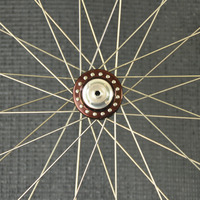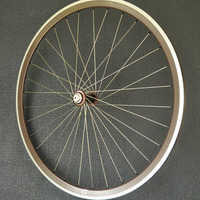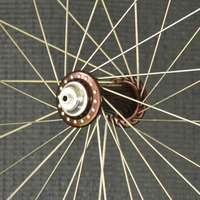- This topic has 25 replies, 16 voices, and was last updated 9 years ago by aracer.
-
Fashion over function – wheel lacing!
-
nemesisFree MemberPosted 9 years ago
Assuming you mean from this page?
http://merlynmechanics.com/productgallery/
You can’t beat a good snowflake 🙂
KahurangiFull MemberPosted 9 years agoYou’re right; you can’t beat a good snowflake. It’s collapsed before you’ve even ridden it. 😉
p.s. image links aren’t working.
nemesisFree MemberPosted 9 years ago🙂 I built up a couple of snowflakes years ago at a mate’s insistence (I told him it’d be his fault if he killed himself to death on them) and they’re still ok now – used offroad for many years…
makecoldplayhistoryFree MemberPosted 9 years agoMy snowflaked Lemon XC715 wheels (LX hubs, green anodised nipples) are going strong on the pub bike well over a decade later.
RetrodirectFree MemberPosted 9 years agoNope, not the snowflaked ones.
Go look at the ones they’ve called “fallon” laced.
cynic-alFree MemberPosted 9 years agoThat’s quite clever.
Functionally though radial is pretty much a waste of time.
bencooperFree MemberPosted 9 years agoThat’s not radial, though – the spokes aren’t going along a radius line, they’re at a tangent to the hub just like crossed spokes. It does rely on having a very stiff hub to work.
Snowflakes are great – built quite a few for my own bikes, the trick is to make sure you do the bends properly.
dirtyriderFree MemberPosted 9 years agobike show late 90’s on the RJ Chicken and Son’s i saw some twisted spokes, never seen them since, anyone any ideas?
shermer75Free MemberPosted 9 years agoInstructions on how to make your own snowflake build. Tempting!
ThePinksterFull MemberPosted 9 years agoI vaguely remember someone selling titanium spokes with a ‘wiggle’ (for want of a better description) in the mid 90’s that was supposed to add a bit of suspension to your bike.
Only ever saw them on a bike once, being raced at Nant Mawr (now there’s a name from the psst!)
bencooperFree MemberPosted 9 years agoOh yes, I remember those – it wasn’t Sapim was it? They also did twirly aero spokes.
I never went more than one complete twist when snowflaking – I think the problems happened when lots of twists made funny angles.
ThePinksterFull MemberPosted 9 years agoCould have been, yes. I just remember them being phenomenally expensive.
orangeboyFree MemberPosted 9 years agoYou bad people , always had this wanting for snow flake wheels when I was young think I’m going to have to build a pair now for the hack road bike
epicycloFull MemberPosted 9 years agoI think snowflake spoking makes a real statement.
“The wheel builder miscalculated the spoke lengths, got round it by doing this ancient bodge and conned me into thinking it’s cool”
🙂
Stevet1Free MemberPosted 9 years agoAnyone remember fiber lyte carbon spokes?
Also you could buy a spoke made out of kevlar cord which could be neatly tucked away then used to temporarily replace a broken spoke.GunzFree MemberPosted 9 years agoIs that ‘Fallon laced’ as in fallon your face and knock your teeth out?
jairajFull MemberPosted 9 years agoThe info for the snowflake design says it makes a stiffer and stronger wheel.
I know very little about wheels, anyone care to explain this in laymen terms, please?
fasthaggisFull MemberPosted 9 years agoOh yes, I remember those – it wasn’t Sapim was it? They also did twirly aero spokes.
I have a 26″ wheel set made with those ( £1 a spoke back in the day).
I used them in XC races and they were fine ,they also looked cool when moving 🙂nemesisFree MemberPosted 9 years agoThe theory on the snowflake is that the twists act to fix the spokes at the point where they twist so that you’ve effectively got a very large hub flange which should make a stiffer wheel. Same theory as tied and soldered spokes. They will be slightly heavier though due to the longer spokes but that will only be a small amount.
Can’t say I ever noticed any difference in stiffness and the downsides are that one broken spoke is effectively two broken spokes (since the other twisted spoke will be loose once the other one of the pair is broken). That was a real issue in the days of rim brakes.
Basically if you like how they look then that’s why you build them that way. Any functional claims in the real world are BS.
As to the ‘Fallon’ laced wheel, I’m sure that’d work absolutely fine so long as you don’t use really spindly hubs (which might twist if subjected to enough torque from braking/power if at the rear).
I still reckon three cross is about right 99% of the time.
aracerFree MemberPosted 9 years ago…which is also bollocks. HTH
As to the ‘Fallon’ laced wheel, I’m sure that’d work absolutely fine so long as you don’t use really spindly hubs (which might twist if subjected to enough torque from braking/power if at the rear).
Leading spokes never completely detension under drive torque and trailing spokes never detension under braking torque – which shows that the static forces on spokes are greater than those due to dynamic loads. The static forces are a problem though, even for normal sized hubs – my instant thought was the stress lacing that wheel will put on the hub.
Using the numbers in the back of Brandt’s “The Bicycle Wheel”, typical flange radius is 21mm, typical spoke tension is 1000N, hence torque from each spoke is 21Nm, or 336Nm in total for 16 spokes in the flange – which has to be transmitted through the hub shaft to the other flange. His calc also suggests 34.7Nm/deg for hub stiffness, so that would result in almost 10 degrees wind up in the hub!! Though it gets worse – again using his figures, I make the shear stress between 530MPa and 740MPa (shear stress increases from the inside to the outside wall). The shear yield stress of even a high performance alu alloy is only ~350MPa…
I presume that typical modern hubs have wider centres than those Brandt measured (his calcs are based on 15mm diameter), but the one pictured isn’t huge, and if you keep the amount of metal used constant (hence thinner walls as the diameter gets larger) then diameter only has a first order effect on the shear stress, so even a 30mm diameter shaft would have a max shear stress of 370MPa. My guess is that they’re using lower spoke tension than normal in order to avoid that problem.
nemesisFree MemberPosted 9 years agoI agree on the snowflake – I’m only saying what people claim 😆
Interesting calcs on the hub though. 10 degree twist sound high – certainly higher than I’d have instinctively thought. Are you assuming that the spokes are tangential to the hub because those in the pic aren’t so the 21Nm figure would be lower and hence you’d get a lower twist.
Right, who’s going to build one to see if the hub gets sheared/twisted to pieces?
aracerFree MemberPosted 9 years agoIagree on the snowflake – I’m only saying what people claim
Thats what I thought, wasn’t aimed at you.
They’re not far off tangential, probably only about a 10% difference in torque – the errors in assumed hub dimensions are greater than that (a flange radius of 24mm would be more than enought to compensate). Hub shell diameter has a second order effect on torsional stiffness (again assuming the same amount of metal), and the pictured hub is mostly much larger diameter, so the actual twist will be less – I think it’s the margin before yield which is the bigger issue as that hub necks down quite a bit in the middle. The calcs suggest a flange diameter twice the diameter of the narrowest point is probably enough for.that to be a problem.
The topic ‘Fashion over function – wheel lacing!’ is closed to new replies.




